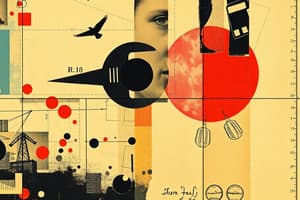Podcast
Questions and Answers
What are the learning targets for this lesson on probability?
What are the learning targets for this lesson on probability?
Recall probability, Identify terminologies of probability, Find sample space of an experiment, Identify the probability of an event
What is the essential question for this lesson on probability?
What is the essential question for this lesson on probability?
How can understanding the concept of probability help to make good decisions in different situations, and what real-world situations show the importance of probability?
What is the definition of probability?
What is the definition of probability?
Probability is a branch of mathematics that analyzes the chance of a particular event occurring. It aims to predict the likelihood of something happening or not happening.
What is an experiment in the context of probability?
What is an experiment in the context of probability?
What is a sample space (S) in probability?
What is a sample space (S) in probability?
What is an event (E) in probability?
What is an event (E) in probability?
What is the formula to calculate the probability of an event?
What is the formula to calculate the probability of an event?
Match the following experiments with their respective sample spaces:
Match the following experiments with their respective sample spaces:
What is the probability of getting a tail when tossing a coin?
What is the probability of getting a tail when tossing a coin?
What is the probability of getting an even number when rolling a die?
What is the probability of getting an even number when rolling a die?
What is the probability of getting two tails when tossing two coins?
What is the probability of getting two tails when tossing two coins?
What is the total number of the sample space when drawing a card from a standard deck of cards?
What is the total number of the sample space when drawing a card from a standard deck of cards?
Flashcards
Probability
Probability
The branch of mathematics that analyzes the chances of events occurring.
Experiment
Experiment
Any activity that can be repeated under similar conditions.
Sample Space (S)
Sample Space (S)
The set of all possible outcomes in an experiment.
Event (E)
Event (E)
Signup and view all the flashcards
Probability of an Event
Probability of an Event
Signup and view all the flashcards
Data
Data
Signup and view all the flashcards
Descriptive Statistics
Descriptive Statistics
Signup and view all the flashcards
Inferential Statistics
Inferential Statistics
Signup and view all the flashcards
Parameter
Parameter
Signup and view all the flashcards
Statistic
Statistic
Signup and view all the flashcards
Discrete Variables
Discrete Variables
Signup and view all the flashcards
Continuous Variables
Continuous Variables
Signup and view all the flashcards
Qualitative Variables
Qualitative Variables
Signup and view all the flashcards
Tossing a coin
Tossing a coin
Signup and view all the flashcards
Rolling a die
Rolling a die
Signup and view all the flashcards
True or False
True or False
Signup and view all the flashcards
Tossing two coins
Tossing two coins
Signup and view all the flashcards
Probability of getting a tail
Probability of getting a tail
Signup and view all the flashcards
Probability of getting and even number
Probability of getting and even number
Signup and view all the flashcards
Probability of getting two tails
Probability of getting two tails
Signup and view all the flashcards
Drawing a card from a deck
Drawing a card from a deck
Signup and view all the flashcards
Probability of drawing a red card
Probability of drawing a red card
Signup and view all the flashcards
Probability of drawing a diamond card
Probability of drawing a diamond card
Signup and view all the flashcards
Probability of drawing an ace of clubs
Probability of drawing an ace of clubs
Signup and view all the flashcards
Probability of drawing a king card
Probability of drawing a king card
Signup and view all the flashcards
Probability of drawing a card that is not a face card
Probability of drawing a card that is not a face card
Signup and view all the flashcards
Tossing three coins
Tossing three coins
Signup and view all the flashcards
Probability of getting exactly two heads
Probability of getting exactly two heads
Signup and view all the flashcards
Probability of getting at least two heads
Probability of getting at least two heads
Signup and view all the flashcards
Probability of getting three heads
Probability of getting three heads
Signup and view all the flashcards
Rolling two dice
Rolling two dice
Signup and view all the flashcards
Probability of getting an even sum
Probability of getting an even sum
Signup and view all the flashcards
Probability of getting a sum higher than 12
Probability of getting a sum higher than 12
Signup and view all the flashcards
Probability of getting a sum between 1 and 13
Probability of getting a sum between 1 and 13
Signup and view all the flashcards
Study Notes
Introduction to Probability
- Probability is a branch of mathematics that analyzes the chance of a particular event occurring.
- Its purpose is to predict the likelihood of something happening or not.
Learning Targets
- Recall the concept of probability.
- Identify probability terminology.
- Determine the sample space of an experiment.
- Identify the probability of an event.
Essential Questions
- How does understanding probability help in making sound decisions in various situations?
- What real-world situations highlight the importance of probability?
Recap of Statistics
- Statistics is divided into descriptive and inferential statistics.
- Descriptive statistics focuses on data.
- Inferential statistics focuses on data variables.
- Data Variables (discrete or continuous)
- Quantitative variables
- Qualitative variables
- Data Variables (discrete or continuous)
- Population (parameter)
- Sample (statistic)
Name it! (Examples)
- Dice
- Playing Cards
- Coins
- Money
Probability of an Event
-
Probability is calculated as the ratio of favorable outcomes to the total possible outcomes.
- Probability = (Number of outcomes favoring the event) / (Total number of outcomes)
- P(E) = n(E) / n(S)
-
Example: Tossing a coin
- Probability of getting tails is 1/2 or 50%
-
Example: Rolling a die
- Probability of getting an even number is 3/6 or 50%
-
Example: Tossing two coins
- Probability of getting two tails is 1/4 or 25%
-
Example: Drawing a card from a deck of 52 cards.
- Total possible outcomes = 52
- Example calculations for card draws are listed in later pages.
Experiment and Sample Space
- Experiment: An activity that can be repeated under similar conditions.
- Sample Space (S): The set of all possible outcomes of an experiment.
- Examples
- Tossing a coin: Heads or Tails
- Rolling a die: 1, 2, 3, 4, 5, 6
- Tossing two coins: HH, HT, TH, TT
- Examples
Let's Try: Experiments and Questions
- Tossing three coins
- How many possible outcomes?
- What is the sample space?
- Probability of getting exactly two heads?
- Probability of getting at least two heads?
- Probability of getting three heads?
- Rolling two dice
- How many possible outcomes?
- What is the sample space?
- Probability of getting an even sum?
- Probability of getting a sum greater than 12?
- Probability of getting a sum between 1 and 13?
Additional Concepts
- Define sample space.
- Formula for finding the probability of an event.
- Definitions of sample space and events.
- Difference between sample space and events.
Studying That Suits You
Use AI to generate personalized quizzes and flashcards to suit your learning preferences.




